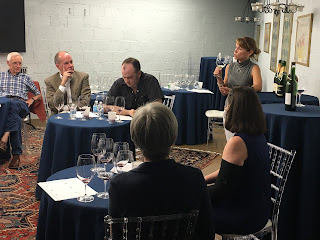Even without bringing the
TTB, three-tier systems and the patchwork of state laws, regulations and statues that pertain to getting wine into the hands of consumers, wine laws around the world are a master course in Byzantine localism, politics and turf warfare.
Bordeaux has strict laws over types of grapes, acerage yield, bottling requirements and a slew of other restrictions and regulations designed to make sure that a wine from Bordeaux tastes like... a wine from Bordeaux. Within the strict national laws implemented by the French government, there are regional battles. Margaux and St-Estephe vie for superiority - and since they are so tightly regulated in what they can grow, how they can grow it and how much they can produce - it is a pretty level playing field that comes down to the winemaker's skills, blending proportions and intangibles such as the terrior where the grapes were grown.
God help us all if we try to figure out the clash of clans that occurs over single hectare in Burgundy or the model of disfunction that is
Italian wine classification...
This is not just an Old World wine problem either. While it is true that the restrictions on grape varietals, yields, etc., aren't as strict, in an utterly American way, pure economics dictates that certain grape varietals be grown in certain areas. The real estate in Napa Valley is far too expensive to fiddle around with things like Sangiovese, Tempernillo or even Pettit Verdot in anything but limited quantities. Cabernet Sauvignon is what people expect, can reap the highest price and is what people want.
Ditto Syrah/Shiraz from Australia and Malbec from the Mendoza region of Argentina.
Indeed much of the wine world's very educational mastery - and snobbery - comes from people who
have studied - and studied extensively - the nuances of the different wine growing regions, their soils, their histories and their grapes.
 |
| Trying to capture the essence of a place: Locations Wines from California, Spain, France and Italy |
So what would happen if these centuries of history, generations of winemaking traditions and decades of government regulation and economic incentives were thrown out the window? What if a winemaker could blend grapes and produce a wine not in the hyper-local tradition that wine is usually made in, but in an national sense? What would a French wine taste like that encompassed both Bordeaux and the Rhone? Could an Italian wine with grapes from both Piemonte and Puglia stand out as truly Italian? Ditto blending different regions of Spain, California or Oregon?
Leave it to winemaking superstar David Phinney of
Orin Swift fame to find out. Phinney is well-known for his blends -
The Prisoner perhaps being his most well-known and highly-rated. Add high praise from none other than
Robert Parker, and you have the possibility of turning centuries of winemaking on its head.
That, at least, is what Phinney's new project
Locations Wines aims to do. Thus far, I have tried the French and Spain blends.
The French wine is a light to medium bodied red comprised of Grenache, Syrah and Bordeaux varietals from the Rhone, Rousssillon and Bordeaux.
 |
| France in a bottle. |
It has hints of cranberry, strawberries and licorice, though lacks the characteristic earthy nose of some regional French wines. Giving the wine some time to breathe did open it up and add complexity to both the bouquet and flavor profile.
The Spanish Locations wine more accurately accomplished what Phinney and his talented team are striving to do: produce a wine indicative of a whole country. With such subtle and specific characteristics in Spanish wines - leather, earth, spice box, dried fruit and chocolate - that permeate the different growing regions, Locations nails it. All the smells I look for in a spanish wine were accounted for, all the flavors were accounted for, and the lingering aftertaste lasted just long enough for the wine to be memorable. It also did have a jammier mouthfeel than most Spanish wines, but that is forgiven based on all the other positive attributes.
 |
A Spanish wine battling the windmills of winemaking tradition, laws and customs.
|
There are some other Locations wines I look forward to trying in the near future. The press materials for Locations Wines says that the driving force is to make wines that are Simple, Complex and Fun. The French wine was more on the "simple" side and the Spanish one was more on the "complex" side. Both were "fun" insomuch as I enjoyed drinking them. If Locations wines does aim to upend how wine is made, taught and enjoyed, then it certainly has its work cut out for itself. Still, there is something satisfying about trying something new - especially if it results in wines like these.











